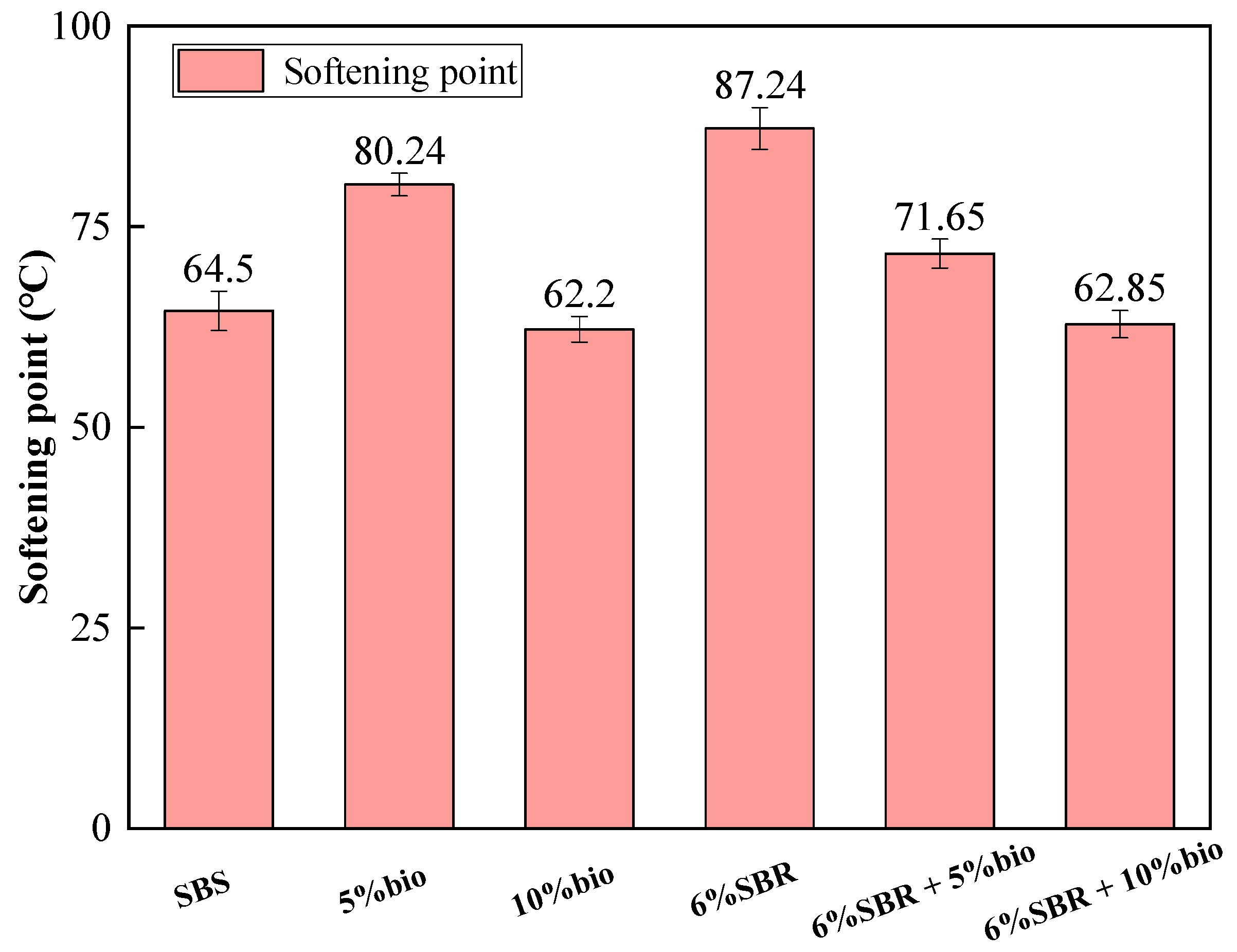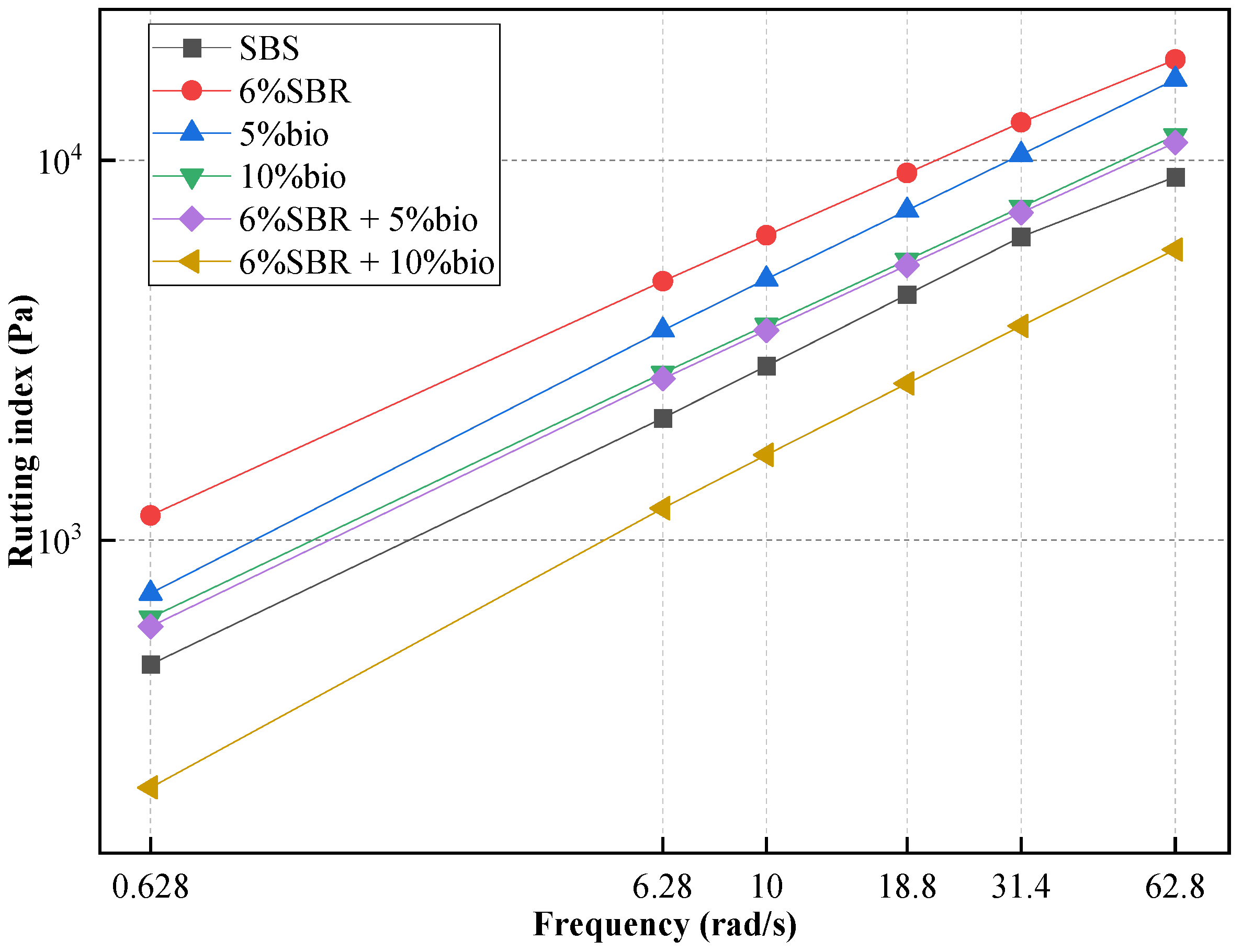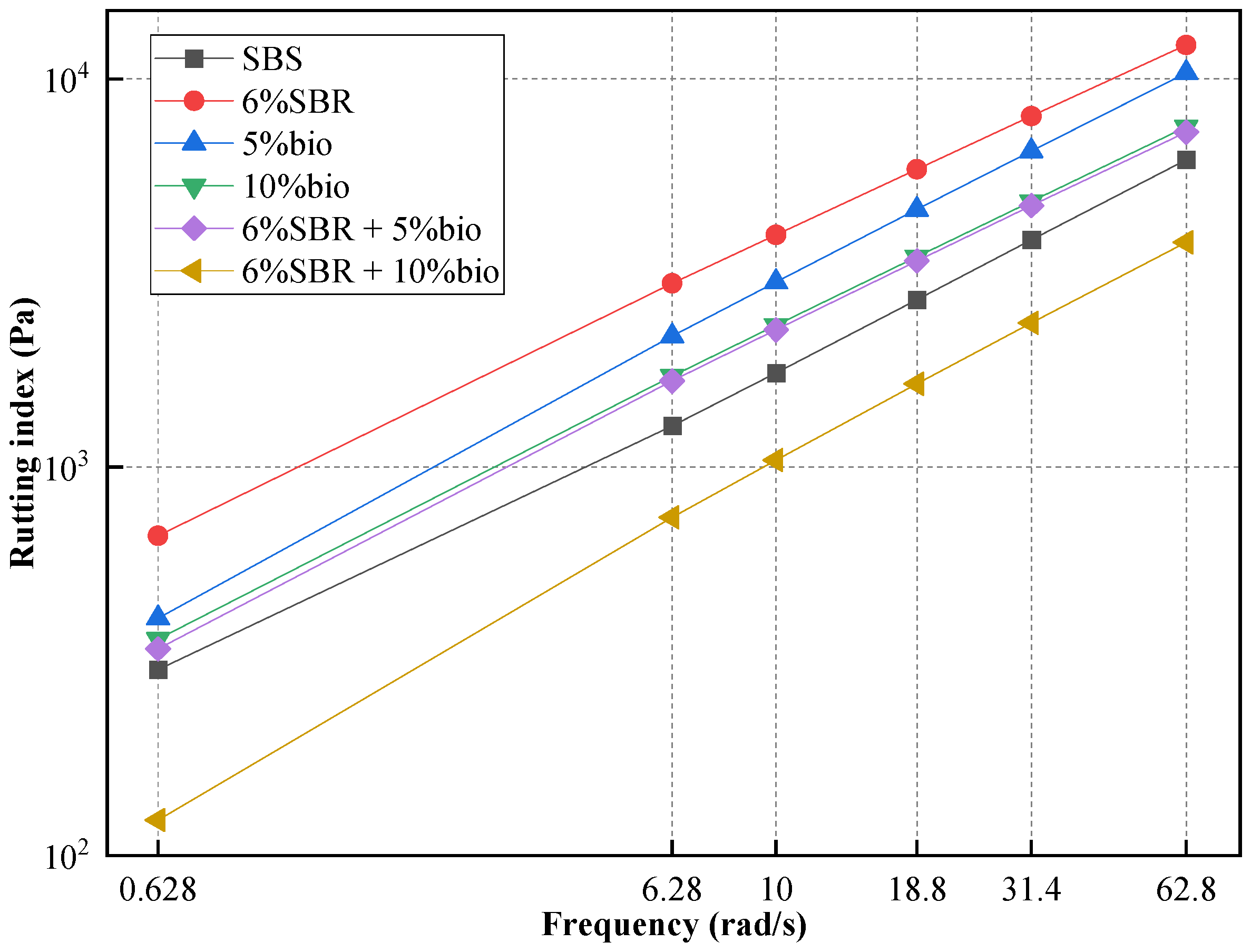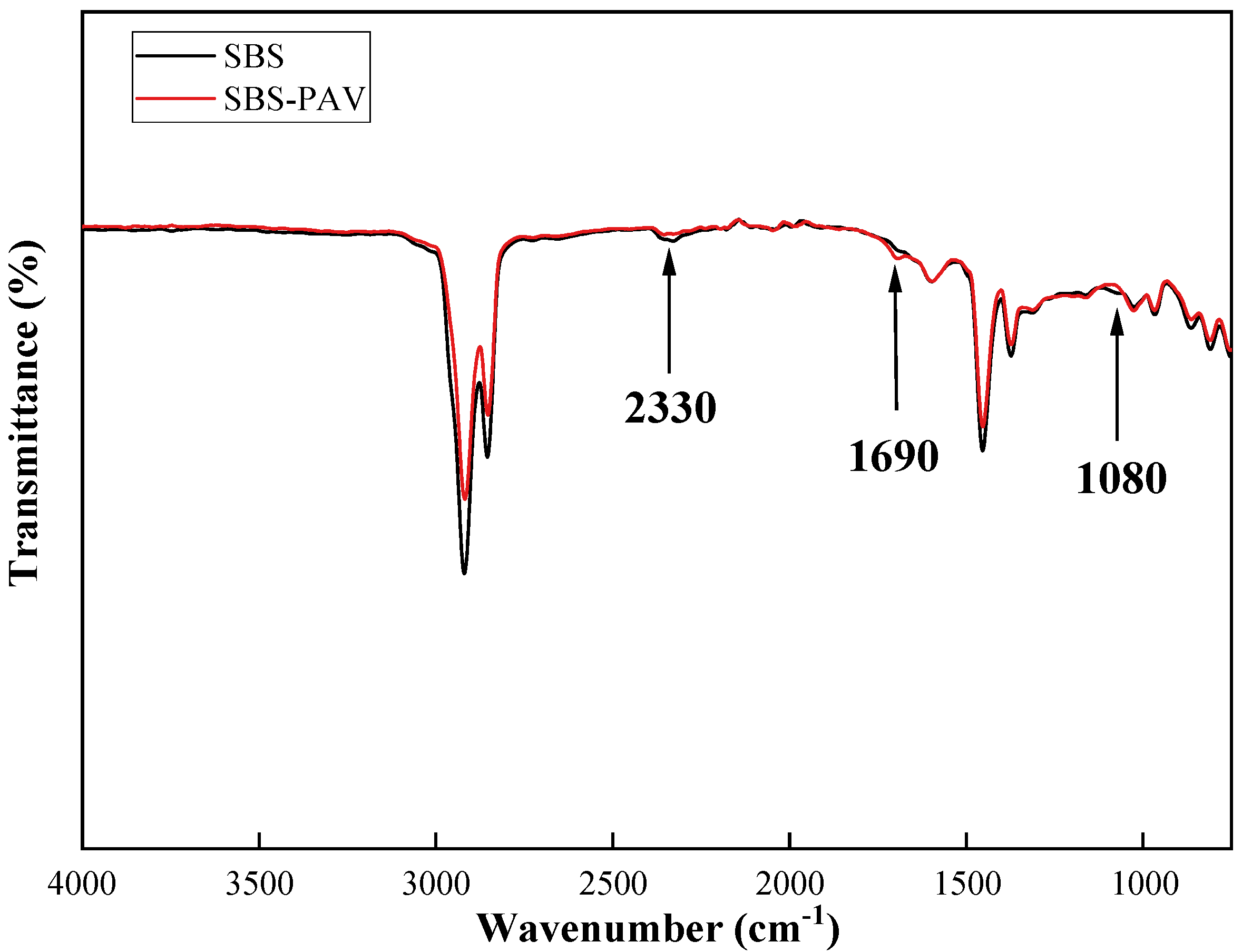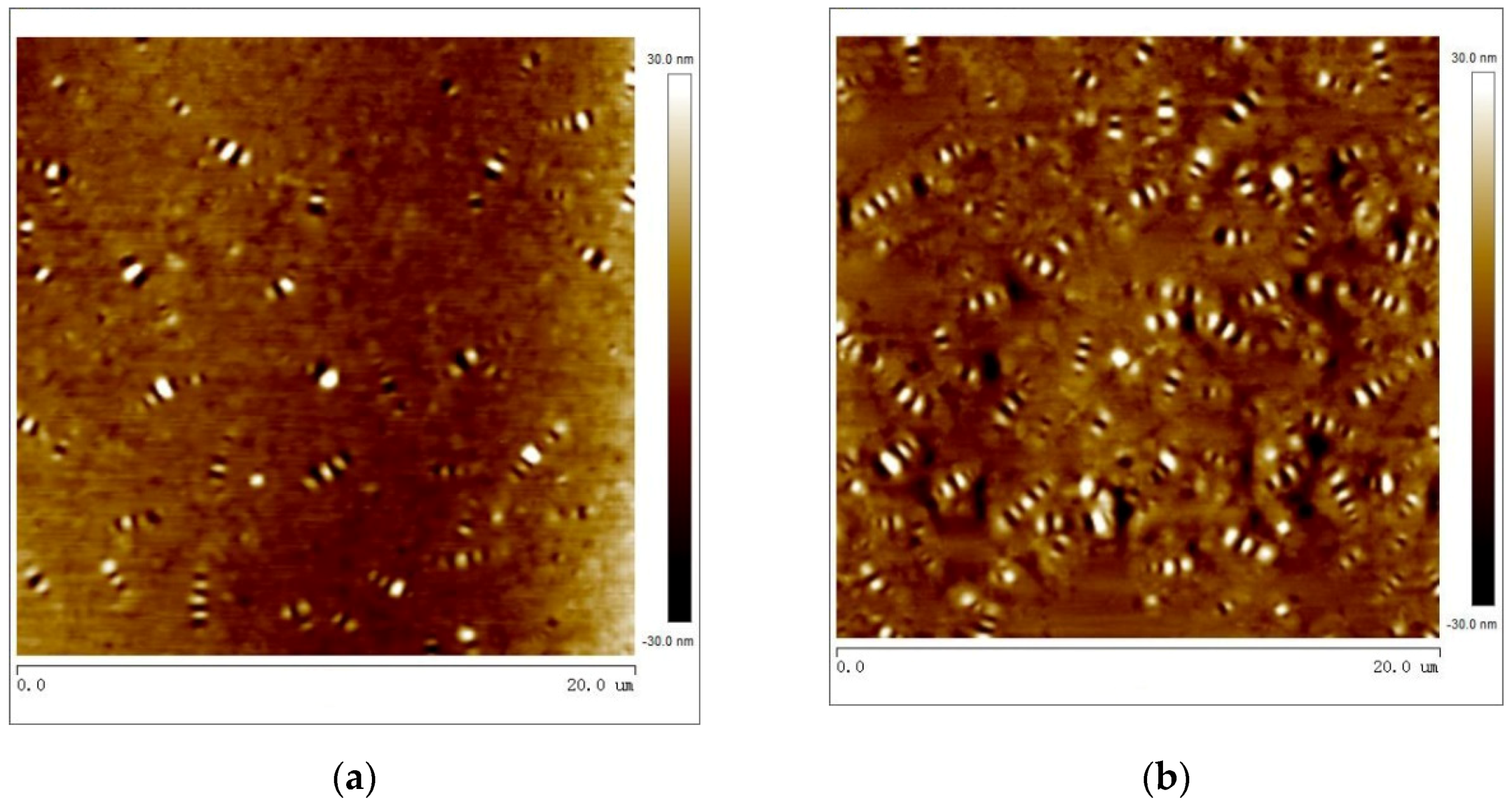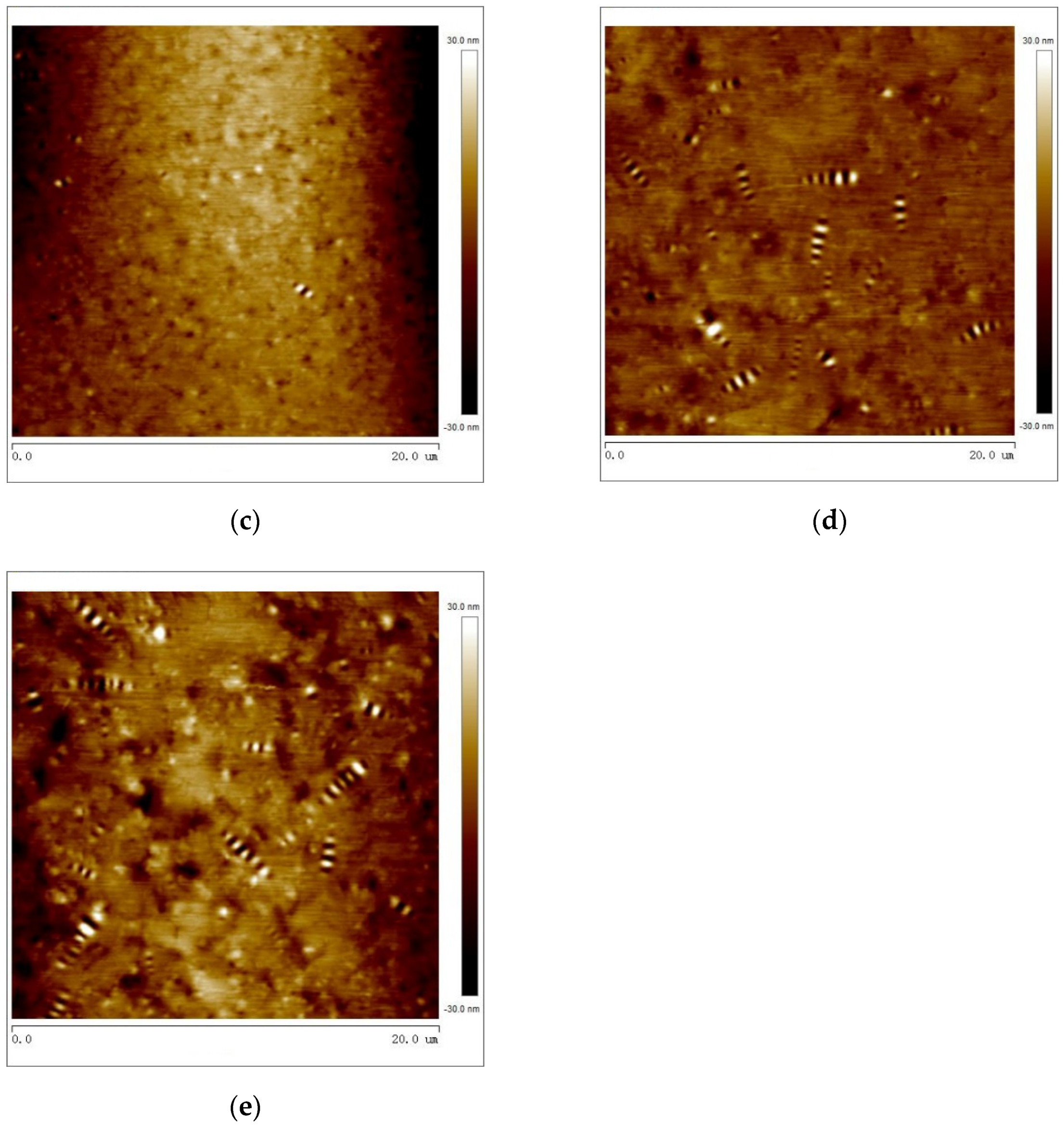1. Introduction
With the development of road engineering and the increase of pavement maintenance mileage, asphalt usage increases yearly. As a by-product of petroleum, asphalt is a non-renewable material. With the extensive exploitation of oil resources, petroleum resources will be gradually depleted. At the same time, the demand for road construction and maintenance increased year by year, and the demand for asphalt also increased. During pavement maintenance, the waste aggregate and aged asphalt will pollute the environment [
1]. For green transportation and environmental protection development, recycled asphalt has become the focus of research.
SBS-modified asphalt has excellent laboratory performance and durability, so it has been widely applied in the field of road engineering [
2]. In the service of asphalt pavement, the ultraviolet rays irradiation [
3] and thermal-oxidative aging [
4] will lead to the volatilization of light components. Meanwhile, the heavy components will generate in asphalt [
5]. After thermal oxidation aging, the penetration, ductility, softening point, and viscosity were decreased [
6]. However, the rutting index, strain recovery rate, and stiffness modulus of asphalt were increased. The anti-cracking ability of the asphalt mixture was dramatically decreased, which led to the deterioration of service performance; it will produce many aged SBS-modified asphalt mixtures, so dealing with the regenerated aged SBS-modified asphalt was a significant problem.
A styrene-butadiene-styrene triple copolymer forms SBS; they create a gel network in the asphalt, strengthening its performance and obtaining good storage stability [
7]. On the one hand, SBS polymer gradually breaks the chain and forms small molecules. The performance of SBS-modified asphalt was affected by the aging of SBS-modified asphalt [
8]. On the other hand, the light components of SBS-modified asphalt volatilized, and the colloid changed to asphaltene. The asphalt gradually becomes stiff and brittle [
9]. The sulfoxide index and aromatic index were significantly increased. During the asphalt aging process, the unsaturated groups break the chemical bond, thus forming polar oxygen-containing functional groups [
10]. Long-term aging of SBS-modified asphalt performance seriously degraded, almost brittle in the 5 °C low-temperature ductility test [
11]. Scholars have discovered that bio-oil could restore the light components lost in asphalt and have conducted extensive research on bio-oil.
The sulfoxide and aromatic hydrocarbon indexes of bio-oil recycled asphalt remarkably decreased, indicating that bio-oil had a better recovery function for aged asphalt [
12]. Lv [
13] illustrated the different modification effects of various bio-oil on aged asphalt. The results showed that bio-oil has good compatibility with asphalt binder. From different sources, bio-oil has different regeneration effects on aged asphalt. Bio-oil can supplement the light components in aged asphalt [
12], increasing the viscosity and reducing aged asphalt’s stiffness [
14]. A.M. [
15] found that the consistency and viscosity of modified asphalt with 5% palm oil were consistent with that of the original asphalt. However, the high content of palm oil will weaken the high-temperature rheological behavior of asphalt. De Medeiros Melo Neto [
16] found that acidified soybean oil can decrease the temperature sensitivity of aged asphalt. Moreover, it will also defeat the hardness and viscosity of aged asphalt. Bio-oil will decrease the complex modulus (G*) of recycled asphalt [
17], and their Jnr will gradually increase as the bio-oil content increases. Girimath [
18] tested that when bio-oil content was 2%, 4%, 6%, 8%, and 10%, the Jnr of recycled asphalt binder was 1.64 kPa, 1.65 kPa, 2.56 kPa, 4.91 kPa, and 7.4 kPa, respectively. The results have indicated that bio-oil could negatively affect the anti-rutting properties of the asphalt mixture. Fang [
19] used bio-oil such as soybean oil and tung oil to regenerate aged asphalt, and it was found that bio-oil can effectively reduce the aging functional group index. Moreover, it can restore the light components of aged asphalt to an unaged level. At the same time, it can also restore the fluidity of aged asphalt [
20].
SBR is characterized by abrasion, heat, and aging resistance, such as SBS; it is a rubber material synthesized from butadiene and styrene as a unit. The cross-linking of rubber can further improve the ductility and anti-aged capability of modified asphalt [
21]. SBR-modified asphalt has better ductility and stress relaxation ability [
22]. Due to the solubilization reaction between SBR and asphalt, the viscosity will increase when the SBR doping exceeds 2% [
23]. Meanwhile, the SBR absorbed the oil in asphalt, which improved the colloidal structure of asphalt. Adding SBR to SBS-modified asphalt also has good compatibility and stability [
24]. Ren [
25] studied the effect of SBR on aged asphalt. SBR could improve the viscosity, activation energy, temperature sensitivity, and flow resistance of recycled asphalt. With the increase of SBR content, the flow resistance of recycled asphalt gradually increased. Li [
26] manifested the stability of cross-linked SBR in different aging periods. The results showed that the cross-linked system remained stable when the aging time was less than 5 h. The viscosity index rapidly increased when the aging time exceeded 5 h, and the cross-linked structure became unstable. SBR-modified asphalt mixture has better anti-fatigue behavior. The durability of the rubber-modified asphalt mixture was improved; its cumulative strain is lower than that of the original mixture. SBR was helpful in the self-healing of cracks [
27]. Che [
28] utilized SBR to regenerate aged asphalt. Due to the SBR, modified asphalt formed new chemical bonds, which increased the viscosity, G*, G*/sinδ [
29]. SBR significantly decreases the creep stiffness of aged asphalt binders. The creep stiffness of aged asphalt with 7% SBR decreased by 79%, indicating that the anti-cracking behavior of recycled asphalt has been ameliorated. Fourier transform infrared spectroscopy (FTIR) results have expressed that new polar functional groups have appeared in recycled asphalt, making SBR-modified asphalt have good elasticity at low temperatures.
In summary, bio-oil was used in the regeneration of aged asphalt. Bio-oil could supplement the light components and enhance the low-temperature behavior of aged asphalt. SBR and SBS have styrene and butadiene copolymer materials, which ameliorate the low-temperature performance. SBR recycled asphalt can also play an excellent anti-fatigue effect; it can provide a new idea for recycled asphalt pavement (RAP). This study conducted laboratory tests on SBR/bio-oil composite regeneration aging SBS-modified asphalt to evaluate its behavior. FTIR and atomic force microscope (AFM) were tested to reveal their microscopic characteristics. This study provides the experimental basis for applying SBR/bio-oil regenerated SBS-modified asphalt.
5. Discussions and Conclusions
SBS was regenerated and aged by mixing 6%SBR and different proportions (5% and 10%) of bio-oil. Conventional properties and rheological properties tests were used to reveal the properties of recycled asphalt. FTIR and AFM experiments were carried out to reveal the regeneration mechanism. The following are the main conclusions of this study.
Under the combined action of SBR and bio-oil, the penetration of aged asphalt was restored. The workability of asphalt regenerated by bio-oil and SBR was improved. Under the effects of 6% SBR and 10% bio-oil, the penetration far exceeds that of SBS. At the same time, the viscosity was obviously reduced.
DSR and BBR tests proved the rheological behavior of recycled asphalt. SBS asphalt after PAV had higher stiffness, and the recovery effect of SBR and bio-oil regenerated asphalt was not enough. Bio-oil has a better viscosity reduction effect and can enhance the anti-creaking behavior of asphalt, but it will weaken the asphalt’s high-temperature behavior. SBR has a general viscosity reduction effect. Adding SBR and bio-oil together in aged asphalt could play their advantages, and the regeneration effect is best.
AFM analysis has shown that bio-oil could soften asphalt, supplementing light components of SBS-PAV. SBR could restore the polymer in asphalt, thus increasing the adhesion and roughness of asphalt, positively impacting the fatigue resistance of the asphalt mixture. The new functional groups in recycled asphalt were known that bio-oil and SBR mainly supplemented with aromatic and polar functional groups at wave numbers of 1000–1270 cm−1. These light components maintain good elasticity at low temperatures; they make the composite recycled asphalt of SBR and bio-oil have good anti-creaking behavior.
In this study, we have contributed to the restoration of SBS-modified asphalt aged with SBR and bio-oil composite by conventional, rheological and microscopic tests on the recycled asphalt. In the next step, we will investigate the effects of various bio-oils and their component differences on the macroscopic properties of recycled asphalt.

